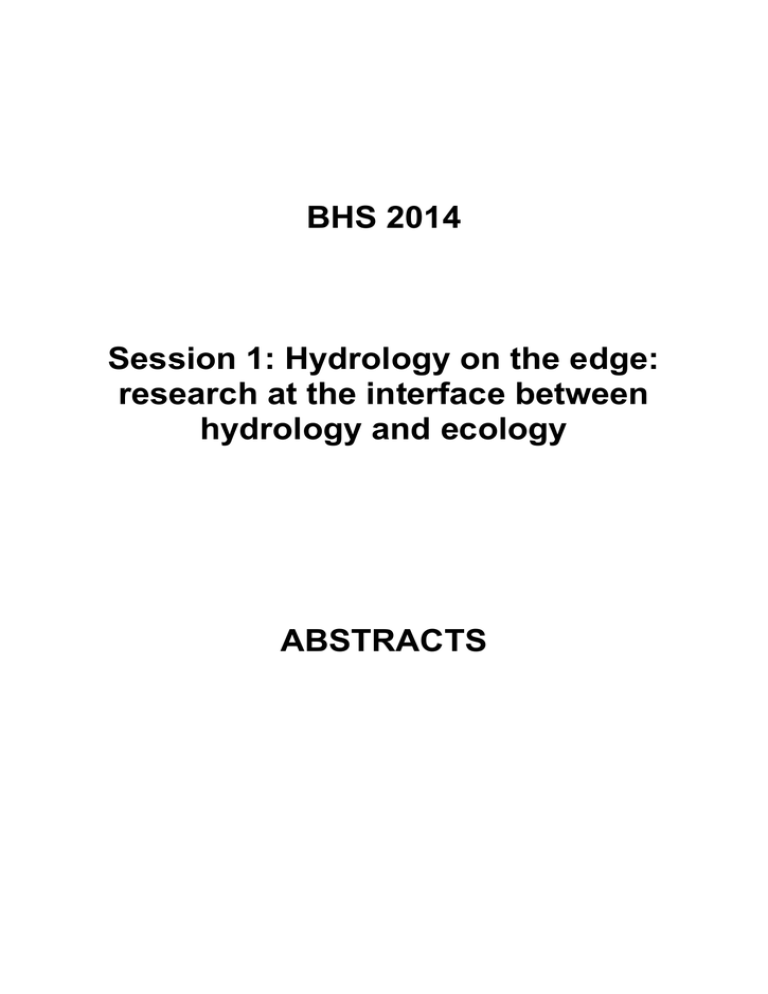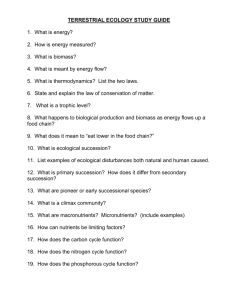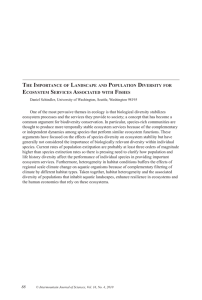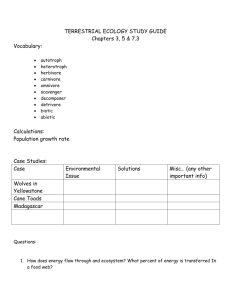Session 1 abstracts - University of Birmingham
advertisement

BHS 2014 Session 1: Hydrology on the edge: research at the interface between hydrology and ecology ABSTRACTS Oral presentations 1-1L: Bringing hydrology, geomorphology and ecology together in the age of climate uncertainty: lessons on what not to do, from the land of 100% pure (New Zealand) R.G.Death, I.C.Fuller, A.M.Death and A.J.Neverman Innovative River Solutions, Institute of Agriculture and Environment, Massey University, Private Bag 11-222, Palmerston North, New Zealand Phone: +64 3569099 84839 Email: r.g.death@massey.ac.nz Rivers and streams in New Zealand are under increasing pressure from a rapid increase in dairy farm intensification, and the construction of irrigation schemes to support that expansion. Although there is considerable rhetoric in New Zealand that integrating hydrology, geomorphology and ecology is one of the best ways to manage any potential anthropogenic influences on the ecosystem health of these water ways, this very rarely occurs in practice. By combining our respective skills in hydrology, geomorphology and ecology we have developed some simple techniques/methods that will assist with truly integrating these three sciences. We will explain how these have been developed and some of their potential future applications. We hope that they will prove useful and effective in better management decisions to balance the use of water in and out of rivers. 1-2L: The ecohydrology of temporary aquatic systems: the influence of hydroperiodicity on management and conservation value of macroinvertebrates. P.J. Wood & M.J. Hill Centre for Hydrological and Ecosystem Science, Department of Geography, Loughborough University, Loughborough, Leicestershire, LE11 3TU, UK. Phone: 01509 223012 Email: p.j.wood@lboro.ac.uk Temporary aquatic ecosystems (springs, streams and ponds) are widespread and common features of the British landscape. However, our knowledge of their hydrology and ecology is limited compared to perennial aquatic systems due to the historic perception that they were of limited wider value. It is now increasingly recognised than many temporary aquatic systems support a unique biodiversity and have significant conservation value. Ephemeral ponds have been poorly studied typically due to the small size or marginal location. Similarly, data availability for the majority of intermittent streams is limited since - most stream gauges and monitoring infrastructure is located in perennial reaches. This paper examines how wetting and drying, and the duration of the aquatic phase (hydroperiodicity) influence the macroinvertebrate ecology of temporary ponds on the River Soar floodplain (Leicestershire) and within the headwaters of the River Lathkill (Derbyshire). The macroinvertebrate communities of intermittent reaches of the River Lathkill are strongly influenced by the timing, frequency and rate of drying of stream flow. The persistence of many fauna is dependent on the presence of aquatic refugia (e.g., perennial springs and subsurface water in caves and soughs) or desiccation / drought-resistant life stages. The invertebrate communities of temporary ponds on the R. Soar floodplain are relatively distinct compared to those of adjacent perennial ponds. However, factors influencing community composition appear to be more stochastic and the duration of the wet phase appears to exert less of an influence on community structure. 1-3L: Froude space: An aquatic “currency” for assessing aquatic habitat abundance and spatial distribution across gravel-bed rivers. Mark S. Lorang1 and Jack A. Stanford2 1 & 2 University of Montana, Flathead Lake Biological Station, Polson, MT, United States. Phone: +1 (406) 982-3301 Ext. 231 Email: mark.lorang@flbs.umt.edu We assess energetic complexity in 14 gravel-bed rivers, from Italy, Montana and 12 other rivers spread across the rim of the North Pacific (e.g. Washington, British Columbia, Alaska, the Kamchatka Peninsula of Russia), using Froude Number (Fr) as our metric, where Fr V gh , and h = depth, V = mean water column velocity and g = 9.81 m/s2. Fr is a hydraulic index of relative specific energy ranging from calm, no flow conditions where Fr = 0 to 0.8 at the onset of rapids and higher values approaching 1 or > at locations of supercritical flow comprised of breaking waves and hydraulic jumps. Most of the water flowing in a gravel-bed river exists in the sub-critical transition range of Fr = 0.1 to 0.8 composing a complex array of water types commonly described as riffles, runs, pools eddies, and so on. We used measures of flow and depth obtained floating in a raft with an Acoustic Doppler current Profiler (ADP) deployed over the side directly determine Fr while observers simultaneously recorded water type (e.g. run, pool) relative to ADP profile number. We then coupled those measures with multispectral satellite imagery (using a distribution-free statistical learner and error analysis approach for image classification) to map water type, depth (h), mean flow velocity (V) and (Fr) beyond what was measured with the ADP. The underlying hypothesis is that energetic complexity equates to a higher potential for sustaining maximum biological diversity, therefore we believe that quantifying the abundance and spatial distribution of Fr as a surrogate index for aquatic habitat provides a common “currency” for ecologic based assessment of gravel-bed rivers. 1-4S: A new multi-disciplinary institute of forest research and its new ten-year+ experiment in environmental resilience Rob MacKenzie, Director of the Birmingham Institute of Forest Research, University of Birmingham, Edgbaston, B15 2TT In November 2013, the Birmingham Institute of Forest Research (BIFoR) was launched to address two major challenges: the impact of climate and environmental change on woodlands, and the resilience of trees to invasive pests and pathogens. BIFoR is a crosscampus institute of the University of Birmingham that aims to engage researchers from Schools as diverse as Biosciences, Physics, Computer Science, Mathematics, Electrical Engineering, Geography, Earth and Environmental Sciences, Civil Engineering, Business School, Sports Science, History and the Medical School. BIFoR, therefore, is at the heart of the university‟s response to societal grand challenges. Hydrology — especially at its interfaces with ecology, meteorology, and human geography — provides one of the essential perspectives underpinning BIFoR. I will provide examples of this underpinning in a description of the 10-year+ environmental resilience experiment to be undertaken by BIFoR. BIFoR will use the major part of its £15m founding endowment to establish a Free-Air Carbon Dioxide Enrichment (FACE) experiment in mature, unmanaged, deciduous woodland. BIFoR-FACE will be one of only two ongoing forest-FACE experiments worldwide, distinctive in its setting in an arable-woodland mozaic. The aim of BIFoR is to establish 30m-diameter woodland patches fumigated by air with above-ambient CO2 but which are unperturbed in every other respect. The CO2 perturbation is maintained at a constant level (+150 ppmv is the current plan), taking account of diurnal and seasonal cycles, vertical gradients, and wind. Top-level research questions to be addressed by the BIFoR-FACE facility are: 1. Does elevated CO2 increase the carbon storage in a mature temperate deciduous woodland ecosystem? 2. Do other macro- or micro-nutrients limit the uptake of carbon in this ecosystem now, or are they likely to in the future? 3. What aspects of biodiversity and ecosystem structure-and-function alter under elevated CO2 and how do these alterations feed back onto carbon storage? 4. How can this ecosystem best be managed for carbon storage under climate change? Many subsidiary research questions have already been identified, including hydrological aspects of the top-level questions above. BIFoR-FACE will be run as an international field facility for environmental research and prospective users are encouraged to contact the Director. 1-5S: Natural or designer environmental flows for a changing world? M. Acreman Centre for Ecology & Hydrology, Crowmarsh Gifford, Wallingford, Oxfordshire OX100LY Phone: +44 1491 692443 Email: man@ceh.ac.uk Environmental flows are the quantities, quality and patterns of water flows required to sustain freshwater and estuarine ecosystems and the ecosystem services they provide for human well-being. There are many environmental flows methods, but most are based on either constraining alteration from a natural flow baseline to maintain biodiversity and ecological integrity or designing flow regimes to achieve specific ecological and ecosystem service outcomes. The former is more applicable to natural and semi-natural rivers where the primary objective and opportunity is ecological conservation. The latter suits modified and managed rivers where return to natural conditions is no longer feasible and the objective is to maximize natural capital, as well as support economic growth, recreation or cultural history; permitting elements of ecosystem design and adaptation to environmental change. Under a future with altered climate and heavy regulation, where hybrid and novel aquatic ecosystems predominate, the designer approach may become the only feasible option. This results from insufficient natural ecosystems from which to draw analogues and the need to support broader socio-economic benefits and valuable configurations of natural and social capital. 1-6S: Quantifying the hydroclimatological controls on diurnal ecological responses C. Broderick1, N.A. Chappell1, W. Tych1, T.D. Jones1, K.J. Beven1, B. Surridge1, J.N. Quinton1 & G. Pereira2 1 Lancaster Environment Centre, Lancaster University, Lancaster LA1 4YQ 2 Centralised Chemistry Facility, Centre for Ecology & Hydrology, Lancaster LA1 4AP Phone: +44 1524 593933 Email: c.broderick@lancaster.ac.uk Diurnal cycles in hydroclimatology and water quality strongly influence the diurnal dynamics of aquatic biology (Volkmar et al., 2012. Chem. Geol. 283: 56-67); however, conducting hydro-biogeochemical monitoring at a sufficiently high resolution to detect diurnal signals has presented a challenge for monitoring programmes - which are typically constrained to sampling at weekly or longer time intervals. This lack of high frequency information has impeded a more complete insight into the dynamics of streamflow behaviour and the processes which regulate water quality and aquatic biodiversity. Here we use high resolution data (e.g. rainfall, streamflow, nitrate, pH, dissolved organic carbon, conductivity) obtained from an ongoing study of experimental catchments in upland Wales to explore diurnal patterns in water quality. The research is being conducted as part of „DURESS‟ (http://www.lancaster.ac.uk/lec/sites/duress/) - a component project of the £13M NERC Biodiversity and Ecosystem Service Sustainability programme. The data set used has been continuously sampled at 15 minute intervals in four catchments near Llyn Brianne. Dynamic Harmonic Regression (DHR) models implemented though the MATLAB-based CAPTAIN toolbox are used to extract the diurnal component from each time series. The model parameters are estimated recursively using a Kalman Filter and Fixed Interval Smoother. This analysis has quantified (with uncertainty) the hydroclimatic behaviour underpinning short term ecological response. 1-7S: Predicting physical habitat sensitivity to abstraction. C.L.R Laizé1, M. Acreman1 & M. Klaar2 1 Centre for Ecology and Hydrology, Crowmarsh Gifford, OX10 8BB, UK Phone: +44 1491692479 Email: clai@ceh.ac.uk 2 School of Geography, Earth and Environmental Science, University of Birmingham, Birmingham, UK, B15 2TT A new version of the Rapid Assessment of Physical Habitat Sensitivity to Abstraction (RAPHSA) model was developed with a specific focus on operational applications. The original RAPHSA defined sensitivity to abstraction as the change in physical habitat with changes in river discharge. Several development needs were identified in order to deploy the model operationally, in particular: (1) Improving the representativeness of the calibration dataset The original model was calibrated using a collection of PHABSIM studies totaling 516 transects at 64 river sites (ie stretches). This dataset is biased towards lowland permeable rivers. As a consequence, the geographical coverage and the river types captured by the model are limited. This issue was successfully resolved by analysing more than 4,000 potential additional sites in England and Wales with detailed hydraulic data, of which 90 were retained by applying a combination of criteria (eg proximity of gauging station, overlap of gauged flow and hydraulic data). (2) Simplifying the model In order to standardise information across calibration sites, the original model uses flow percentile ranks, thus requiring the derivation of the flow duration curve prior to any run. The new version instead standardises with bankfull flow, which can be estimated from a single site hydraulic survey. In addition, fewer predictors are used. A Jackknifing procedure was run on both models, which performed very closely. The new RAPHSA has slightly higher mean squared errors, which is likely due to being calibrated on a wider range of river types than the original model. Poster presentations 1-1P: Contrasts in water and wave travel times and dispersal from Kielder releases and implications for salmonid migration. D Archer JBA Consulting Engineers and Scientists, South barn, Broughton Hall, Skipton, N Yorks, BD23 3AE, Phone: +44 1661 834063 Email: davearcher@yahoo.com Water released from Kielder reservoir for the generation of hydropower shows contrasting patterns and timing of movement between the release wave and the released water. Wave travel time can be determined from gauged flow records. The release rising limb of the hydrograph of 2 hours at the outlet steepens to less than 1 hour 8 km downstream and this is maintained to the estuary. Water travel time is determined by tracking the change in conductivity from before to after a Kielder release at a downstream site which shows that the first evidence of the change in conductivity is several hours after the arrival of the release wave. Conductivity does not stabilise to a new steady value, indicating complete mixing, until more than a day after initial detection. The delay in stabilisation indicates the attenuation and dispersal of the Kielder water in comparison to the release wave. Results for arrival times are in line with theoretical estimates of VW/V obtained by combination of Manning‟s equation with the Kleitz-Seddon equation. The difference in travel and arrival time of release wave and water provides the potential to assess physical attributes of the wave and chemical and olfactory effects of the water on salmonids making the transition from the estuary to freshwater. The paper will attempt to explain the pattern of variations in hourly fish count at Riding Mill arising from Kielder releases and assess the comparative merits of physical (wave) and olfactory (water) factors in explaining fish movement. 1-2P: Ecological response to flow change and water abstraction: evidencebased models from monitoring data M.J. Dunbar1, N. Birkby2, R. Chadd3, J. England4, C. Extence3, J. Hall5, C. Howarth5, M. Morgan6, M. Warren7 1 Environment Agency, Kings Meadow House, Reading, RG9 1TB, UK Phone: +44 1189 535177 email: mike.dunbar@environment.agency.gov.uk 2 Environment Agency, Bromholme Lane, Brampton, Huntingdon, PE28 4NE, UK 3 Environment Agency, Stepping Stone Walk, Spalding, Lincolnshire PE11 1DA, UK 4 Environment Agency, Howbery Business Park, Wallingford, Oxfordshire, OX10 8BD, UK 5 Environment Agency, Deanery Road, Bristol BS1 5AH, UK 6 Environment Agency, 2 Bishop Square Business Park, Hatfield, Herts. AL10 9EX, UK 7 Environment Agency, Newtown Industrial Estate, Tewkesbury, GL20 8JG, UK We need to quantify the environmental impacts of altered river flows and to develop tools for setting environmental flow regimes. The costs of addressing impacts from over-abstraction are high, hence our tools underpinning decision making need to be robust. We have an unprecedented historical archive of ecological monitoring data from rivers and unparalleled access to observed and modelled data on flows, water abstractions and other pressures. While most biological quality elements respond to flow in certain situations, our most complete knowledge of ecological response to flow comes from the macroinvertebrate community. Site-specific ecological data are often considered the “gold standard” in hydroecological investigations. However we often struggle for the time to collect adequate data series for robust site-specific relationships. Since 2005 we have developed a series of generic hydro-ecological models which define relationships between ecological metrics and hydrological variables describing flow and / or abstraction. These models assimilate even short series of local monitoring, producing an optimum blend of local (accurate) and generic (precise) data. The models have been configured using macro-invertebrate metrics as response variables but the principles can potentially be applied to any relevant ecological group. They have improved our understanding of the factors, anthropogenic and natural, which appear to control ecological response to flow change, and the response to developing drought. Our current challenge is to develop tools which work for large numbers of waterbodies within the framework of Water Framework Directive classification. 1-3P: Catchment measures to improve the low flow environment in rivers. J. England1, S. Bentley2 D. Mould3 H. Reid4 C. Wallis5 A. Large6 & C.Bithell7 1 Environment Agency, Red Kite House, Howbery Park, Crowmarsh Gifford, Wallingford. OX10 8BD Phone: +44 7836 634906 Email: judy.england@environment-agency.gov.uk 2 JBA Consulting, The Library, St Philips Courtyard, Church Hill, Coleshill, Warwickshire, B46 3AD Phone: +44 1675 437 750 Email: Sebastian.Bentley@jbaconsulting.com 3 JBA Consulting, South Barn, Broughton Hall, Skipton, North Yorkshire, BD23 3AE Phone: +44 1756 799 919 Email: David.Mould@jbaconsulting.com 4 Environment Agency, Ghyll Mount, Gillan Way, Penrith 40 Business Park, Penrith, Cumbria, CA11 9BP Phone: +44 1768 215 859 Email: helen.reid@environment-agency.gov.uk 5 17 Zenoria Street, London, SE22 8HP Phone +44 7811 384641 Email: carolinertw@hotmail.com 6 Daysh Building, University of Newcastle, Newcastle upon Tyne, NE1 7RU Phone: +44 191 208 6342 Email: andy.large@newcastle.ac.uk 7 JBA Consulting, Sankey Street, Warrington, Cheshire, WA1 1NN. Phone +44 192 557 0876 Email: Claire.bithell@jbaconsulting.com The Environment Agency‟s objective to achieve good ecological status/ potential in rivers along with potential impacts from climatic change have emphasised the need for us to have a better understanding of the dynamic nature of catchments for river basin planning, targeting improvement measures and preventing deterioration in ecological quality. We want to develop evidence of measures that enhance physical habitats, particularly during low-flow conditions and channel forming flows, to promote ecological resilience. There is a growing body of practical experience, but we are keen to develop evidence and understanding through 2D hydrodynamic modelling. The 2D model output was analysed using a range of tools including hydraulic biotope mapping and fisheries habitat modelling to assess the changes and benefits that can be realised from a few examples of interventions that have the potential to be widely used. There is also a need to develop an opportunities mapping approach so that we can target interventions to where they are appropriate and can have greatest impact. The concept of catchment acupuncture has been proposed in the past whereby we identify the catchment hotspots for intervention. The outcomes from this project are worked examples that illustrate the changes that can be achieved in river physical habitat from appropriate morphological interventions. In addition the project scopes out site selection criteria for implementing the selected interventions. 1-4P: Using habitat models to demonstrate how low flows affect Brown trout (Salmo trutta) populations in a UK river Jennifer Garbe1, Dr Lindsay Beevers2, Prof Gareth Pender3 1 Institute of Infrastructure and the environment, Heriot- Watt University, Edinburgh, EH14 4AS Email: jag14@hw.ac.uk Phone: 07731735217 2 Institute of Infrastructure and the environment, Heriot- Watt University, Edinburgh, EH14 4AS Email: l.beevers@hw.ac.uk 3 Institute of Infrastructure and the environment, Heriot- Watt University, Edinburgh, EH14 4AS Email: g.pender@hw.ac.uk Alteration of natural flow regimes caused by anthropogenic activities are affecting freshwater environments around the world (Malmqvist, 2002). In the UK natural flow regimes are influenced by amongst others, land use change, water abstraction and transfer, hydro electric power generation and flow impoundments. Water abstraction and transfers are a particular issue causing low flows and exaggerating the effect of drought. In some instances deterioration had lead to an associated impact on salmonoid populations. Fish have a basic requirement of; adequate flows at appropriate times of the year, appropriate water velocities, volumes and depths for spawning fish, and regular occurrence of flushing flows. Low flows exacerbated by human influence can negatively affect the conditions required for fish. This study seeks to assess how these low flows are affecting fish populations as not only do fish provide food and recreation, they also provide important ecosystem services vital to the functioning of a river ecosystem. Using the river Nar in Norfolk (UK) as a case study, 1D and 2D habitat models are developed using field data and hydraulic model output. Habitat changes are shown for a wet year, dry year and an average year. Analysis of the results focuses on the changes to flow and thus habitat for spawning, juvenile and adult brown trout. Conclusions are given on subsequent impacts on species resulting from flow alterations. 1-5P: Ecosystem responses to artificial floods from a reservoir in Britain B. Gillespie1, P. Kay1 & L. E. Brown1 1 School of Geography, University of Leeds, Leeds, UK, LS2 9JT Phone: +44 770 868 7641 Email: gybrg@leeds.ac.uk Reservoirs can impact downstream ecosystems and there is now a drive (stimulated by the EU Water Framework Directive) to mitigate these impacts through use of artificial floods (i.e. releases of water from a reservoir to emulate natural flooding). Currently, understanding of impacts of artificial floods on downstream ecosystems in Britain is very limited. The impact of a series of artificial floods (n=4) of varying hydrological characteristics on downstream physical chemistry (dissolved oxygen, temperature, electrical conductivity and pH), coarse sediment transport and benthic macroinvertebrate assemblages was assessed. Physicalchemical responses varied between artificial floods likely representing interactions between the hydrological characteristics and timing of each artificial flood. Coarse sediment transport occurred during the artificial flood of highest peak magnitude allowing for identification of a threshold discharge required to stimulate coarse sediment transport. Contrary to hypothesised expectations, little evidence for impacts of artificial floods on macroinvertebrate assemblages was observed potentially reflecting the hydrological characteristics of each artificial flood or the resilience of the macroinvertebrate assemblage at the study site. Potential for use of artificial floods as an ecosystem management tool was demonstrated, but further research to (i) examine the impacts of further artificial floods of alternative hydrological characteristics and, (ii) better understand complexities between factors controlling ecosystem responses is required to enable informed reservoir management decisions to be made in Britain. 1-6P: Developing technical resilience in hydroecology within the Environment Agency: a hydroecology training programme Caroline Howarth, Mike Dunbar, Mark Warren and Phil Humble. Environment Agency, Horizon House, Deanery Road, Bristol, BS1 5AH Phone: 01179344869 Email: caroline.howarth@environment-agency.gov.uk Historically, the Environment Agency has had very limited formal mechanisms for developing and maintaining the hydroecological expertise and understanding of its staff. Technical expertise in hydroecological assessments was often concentrated into a small number of individuals, whilst general awareness in the wider business of the importance of using hydroecology in our water resources decision-making was limited. This lack of technical resilience in hydroecology posed the risk to the EA of not having enough people with the right expertise and the potential for losing specialist skills. To address this problem the national Hydroecology team are currently developing a hydroecology training programme to provide staff with the hydroecological knowledge and expertise they need. This structured training programme will be a suite of training materials aimed at developing the hydroecological knowledge of staff across the EA and aimed at the whole capability range from general awareness through to expert level. It will be a mix of both formal elements, such as taught courses and guidance documents, to informal elements, including technical working groups and use of social media. The formal courses are currently being developed and will include a basic level introductory e-learning package, an intermediate technical classroom course and a taught hydroecology technical foundation course. Other advanced specialist courses for hydroecological tools will also be developed as required. The ultimate aim of the hydroecology training programme is to improve understanding of hydroecology and its importance within the EA, as well as developing resilience in the technical skills required to carry out hydroecological assessments to inform our water resources decision-making. 1-7P: Multiple Scales of Hot Spots and Hot Moments of nutrient attenuation in streambed and riparian zones L.Rose1, S. Krause1,* & D. M. Hannah1,** 1 School of Geography, Earth and Environmental Science, University of Birmingham, Birmingham, UK, B15 2TT, Phone: +44 121 4143575 Email: lxr230@bham.ac.uk * Email: s.krause@bham.ac.uk ** Email: d.m.hannah@bham.ac.uk The Water Framework Directive aims to achieve the good chemical status of all water bodies in a holistic manner based on an integrated management of surface water and groundwater. Special attention is given to the interactions at the hyporheic zone, the interface between these two environments. This project aims to quantify the contribution of small scale hyporheic dynamics on the spatial and temporal distribution of nutrients in a lowland catchment in order to understand the importance of these interactions for the achievement of good environmental and water quality status at catchment scale The work in progress focuses on understanding the impact of low conductivity layers on intermeander and streambed hyporheic flow in terms of volume of water exchanged and residence time distributions and their role in enhancing locally (Hot Spots) and temporally (Hot Moments) nutrient cycling. This poster presents a comprehensive review of the drivers of increased reactivity at Hot Spots or during Hot Moments, and identified gaps in their current description. In addition provides a conceptual model of the hyporheic and riparian process dynamics in the catchment of study, the proposed modelling scenarios considered to address the impact of low conductivity layers, as well as preliminary results. 1-8P: Towards simultaneous mapping of 3D water velocities, bathymetry and the river bank environment with a single remote control sensor platform Thomas Kriechbaumer1, Kim Blackburn2, Toby Breckon3, Andrew Gill4, Nick Everard5, Ros Wright6, Monica Rivas Casado7 1 Cranfield University, Department of Environmental Science and Technology, Cranfield, UK, MK43 0AL, t.kriechbaumer@cranfield.ac.uk,+44 07454 001948 2 Cranfield University, Department of Environmental Science and Technology, Cranfield, UK, MK43 0AL, k.blackburn@cranfield.ac.uk, +44 (0) 1234 750111 x2834 3 Durham University, School of Engineering and Computing Sciences, Durham, UK, County Durham DH1, toby.breckon@durham.ac.uk, +44 (0) 191 33 42396 4 Cranfield University, Department of Environmental Science and Technology, Cranfield, UK, MK43 0AL, a.b.gill@cranfield.ac.uk, +44 (0) 1234 750111 x2711 5 Environment Agency, Hydrometry & Telemetry, Wallingford, UK, OX10 8BD, nick.everard@environment-agency.gov.uk, +44 (0) 1491 828400 6 Environment Agency, Fisheries & Biodiversity, Feering, UK, CO5 9SE, ros.wright@environment-agency.gov.uk 7 Cranfield University, Department of Environmental Science and Technology, Cranfield, UK, MK43 0AL, m.rivas-casado@cranfield.ac.uk, +44 (0) 1234 750111 x2706 The spatially explicit quantification of hydraulic features provides valuable information for physical in-stream habitat assessments. The collection of data on water velocities and depths using in-situ current meters or acoustic sensors on tethered boats is time-consuming and requires good site accessibility. This poster presents (1) a new small-sized remote control sensor platform for the time-effective hydraulic characterisation of in-stream habitats and (2) the testing of visual Simultaneous Localisation and Mapping (SLAM) for platform positioning and 3D mapping of the river bank environment. It highlights the manifold opportunities that recent achievements in computer science and open-source electronics create for the environmental sciences in general and for eco-hydraulics in particular. The platform carries an acoustic Doppler current profiler (ADCP) to measure water velocities and river depths, from which hydraulic variables with ecological relevance can be derived, e.g. the spatial water velocity distribution, turbulence parameters and bathymetry. Stereo-vision based SLAM is a well-established technique in the field of robotics. In eco-hydraulic studies, it has the potential to enable spatial ADCP-data referencing in areas with limited view to GPS satellites and to provide 3D maps of the river bank environment. The combination of ADCP technology and visual SLAM on a single remote control platform provides novel opportunities for the assessment of riverine habitats below and above the water surface. 1-9P: Title: An integrated assessment of hydrologically sensitive upland habitats Authors: Jamie Ledingham, Tim Jolley and Emma Wren (all of Mott MacDonald) Mott MacDonald, 1 Atlantic Quay, Broomilaw, Glasgow G2 8JB, United Kingdom Protecting Groundwater Dependent Terrestrial Ecosystems (GWDTEs) is one of a number of requirements of the Water Framework Directive. The recent increase in renewable energy development, particularly in upland areas of the UK has focused concern on the identification of these habitats and their status. We outline an integrated assessment method using detailed field survey combined with GIS analysis and a conceptual model of the local hydrology. This method provides a scientific basis to assessing the potential impact of renewable energy infrastructure using both ecological and hydrological knowledge, and improves upon the typical approach of using large buffers to constrain infrastructure design. The approach has been applied successfully to a number of Scottish wind farm sites as a means of assessing flow paths and refining buffers. As well as providing an outline of the method, we briefly touch upon related hydrological impacts of upland developments and outline the current knowledge gaps.‟ 1-10P: Deriving flow building blocks to meet good ecological potential (GEP) in a complex water resources system E. Willmott1 & R. Gosling2 1 SEPA, 7, Whitefriars Crescent, Perth, UK, PH1 3JZ Phone: +44 1738 627989 Email: ellen.willmott@sepa.org.uk 2 SEPA, Graesser House, Fodderty Way, Dingwall, UK, IV15 9XB Phone: +44 1349 860393 Email: richard.gosling@sepa.org.uk The EU Water Framework Directive stipulates that the environmental objective for those rivers designated as heavily modified should be to achieve good ecological potential. This is the best environmental outcome that can be achieved practically without resulting in a significant impact on the designated use. To achieve this objective, the UK environment agencies have developed guidance on setting environmental flow releases from reservoirs using a flow building block approach. These building blocks aim to achieve specific ecological outcomes such as flows to support species dispersal and fish migration as well as the minimum base flow to support a functioning ecosystem. This paper presents a methodology for deriving flow building blocks for a complex hydropower scheme in Scotland. The scheme in question straddles two of the larger catchments in Scotland and comprises numerous abstractions, cross-catchment transfers, storage reservoirs and power stations. In order to fully account for the complexity of the system a water resources model has been constructed using AQUATOR software with over sixty natural catchment inputs each requiring time-series data. The paper focuses on the different methodologies used for deriving the natural inflows and the resulting calibrations against long-term data sets. The results explore the sensitivity of the model outputs to the choice of inflow time series. The paper also looks at how, once built and calibrated, the model has been used to determine the appropriate magnitude and frequency of the building blocks at specific points within the system taking account of natural and influenced inter-catchment flows, operational rules and mitigation flows.





